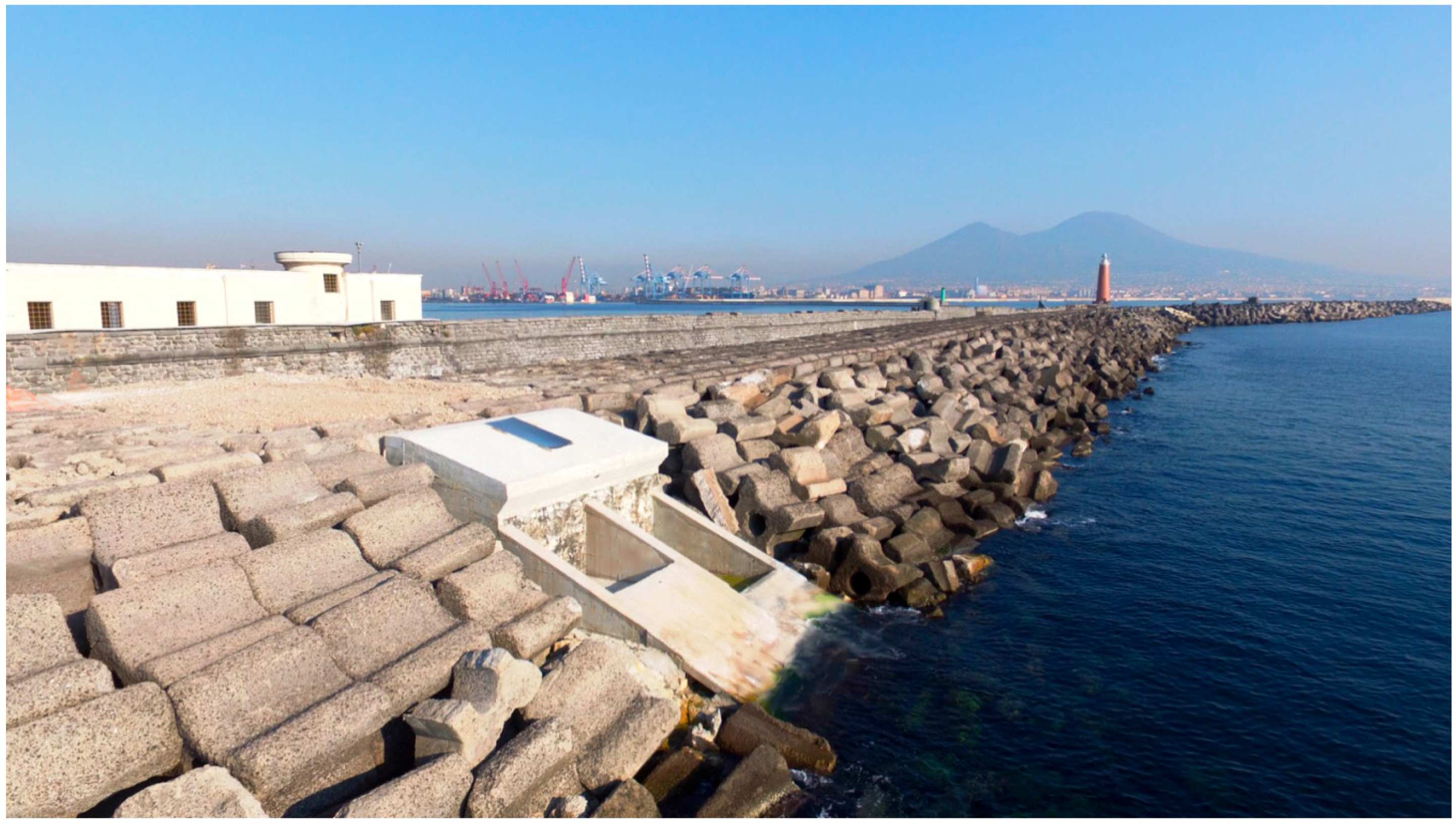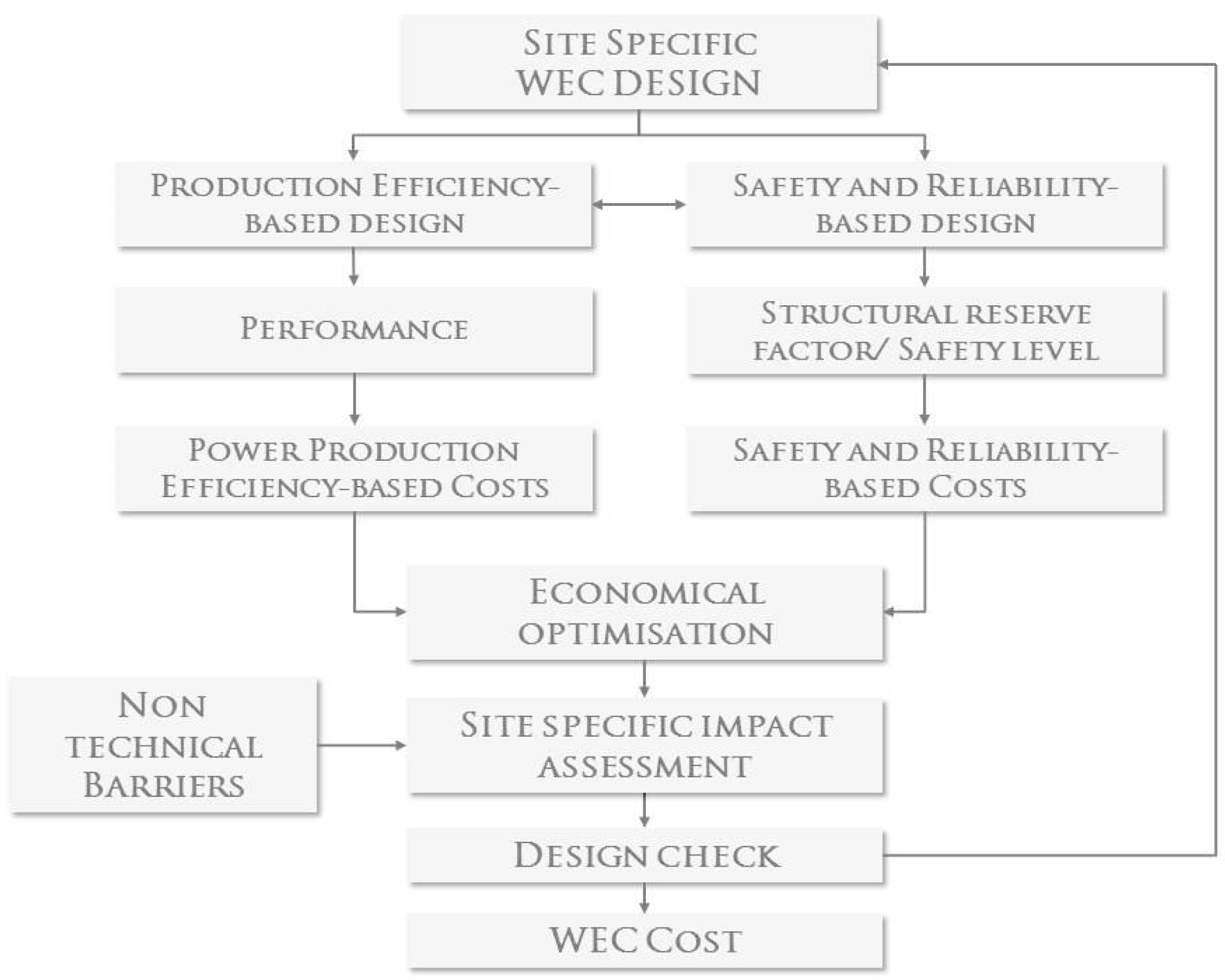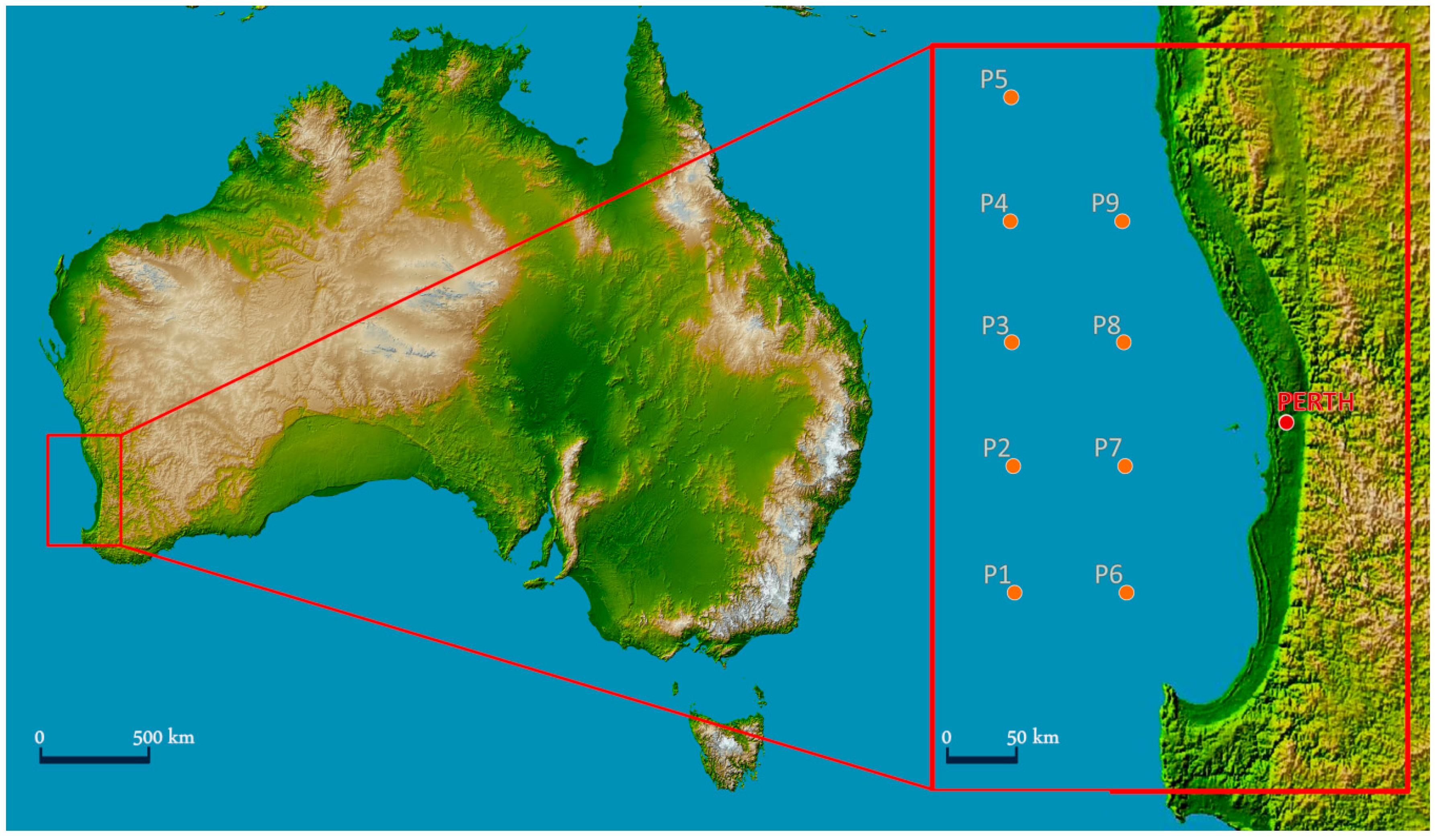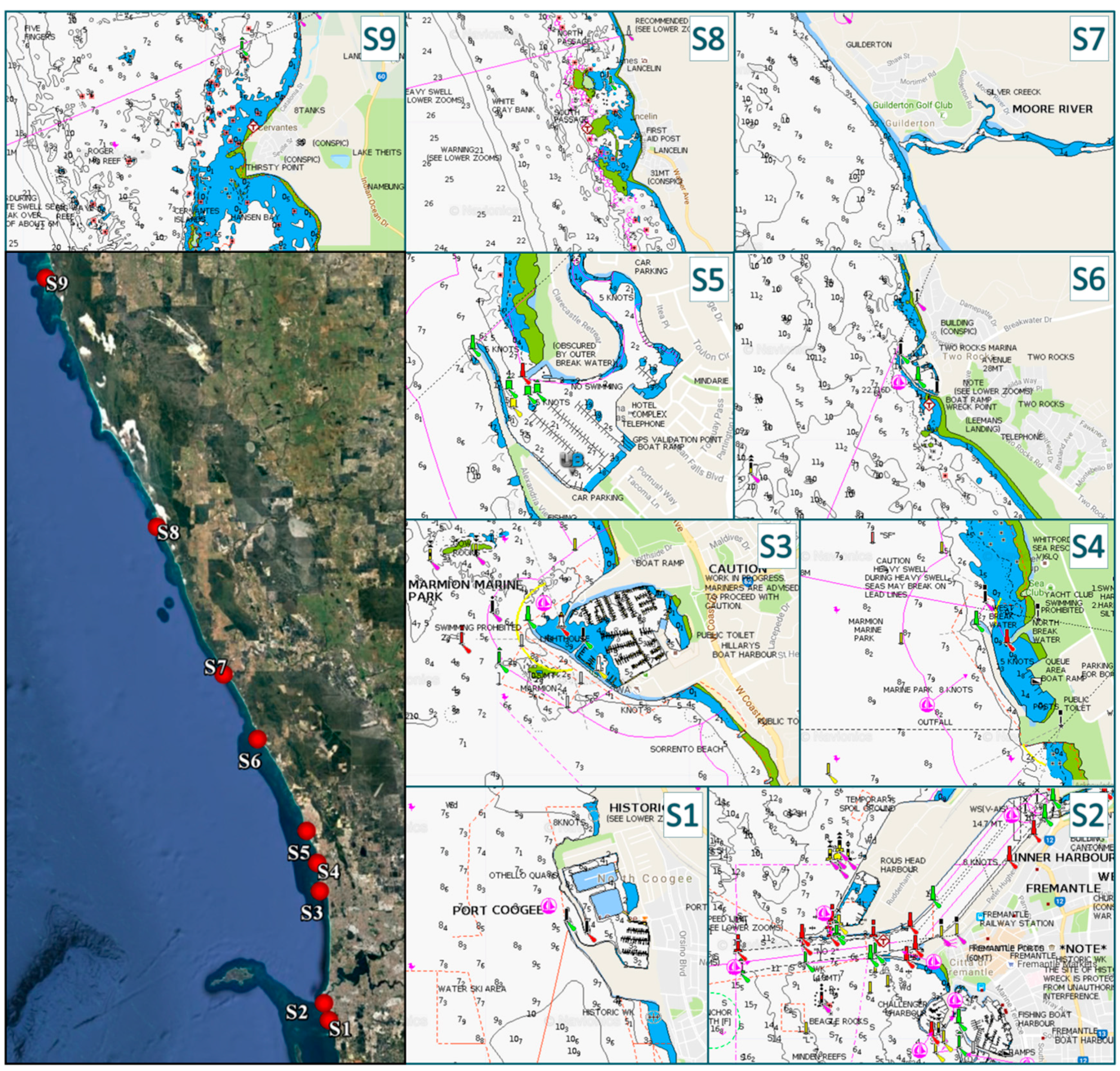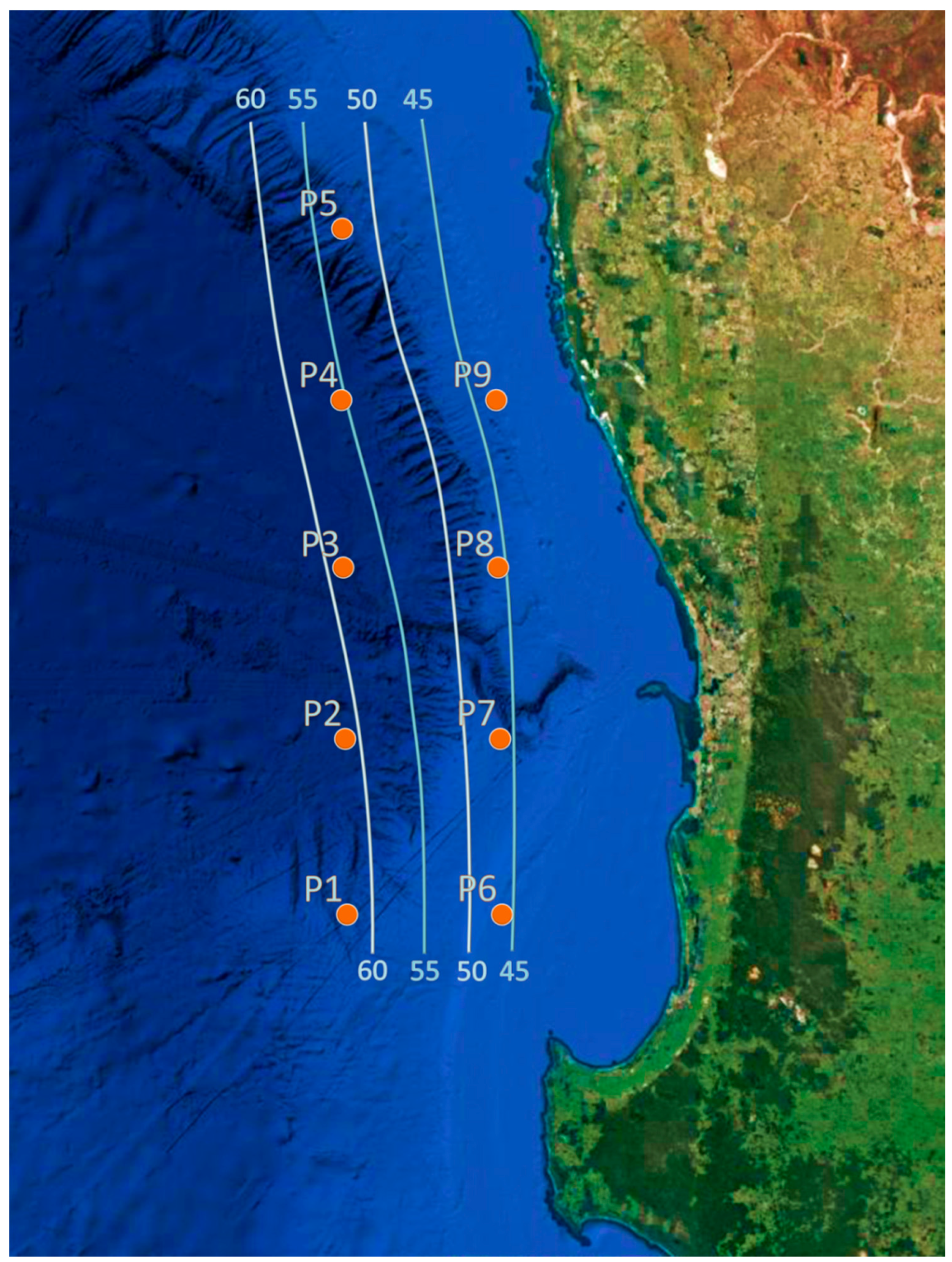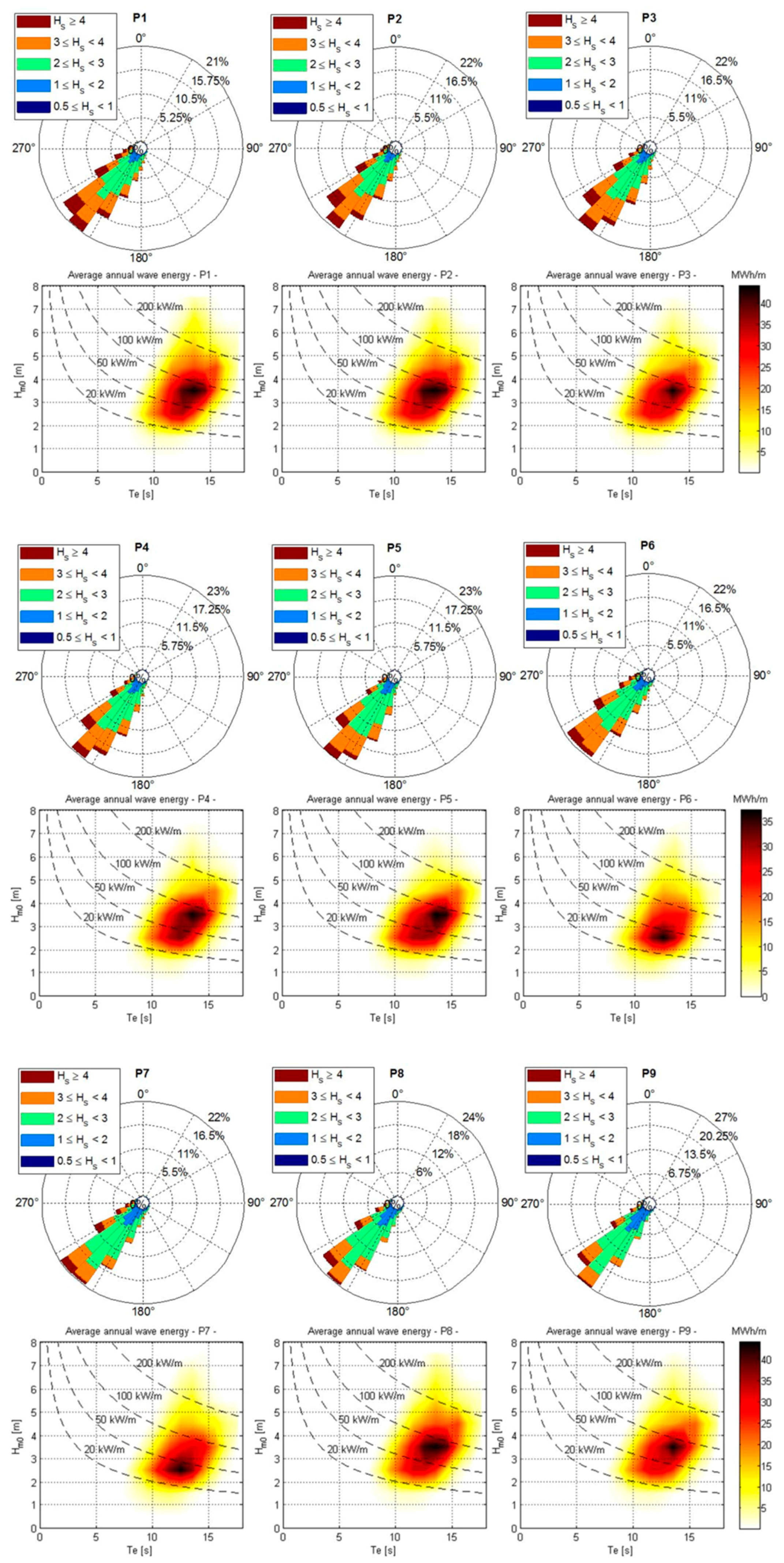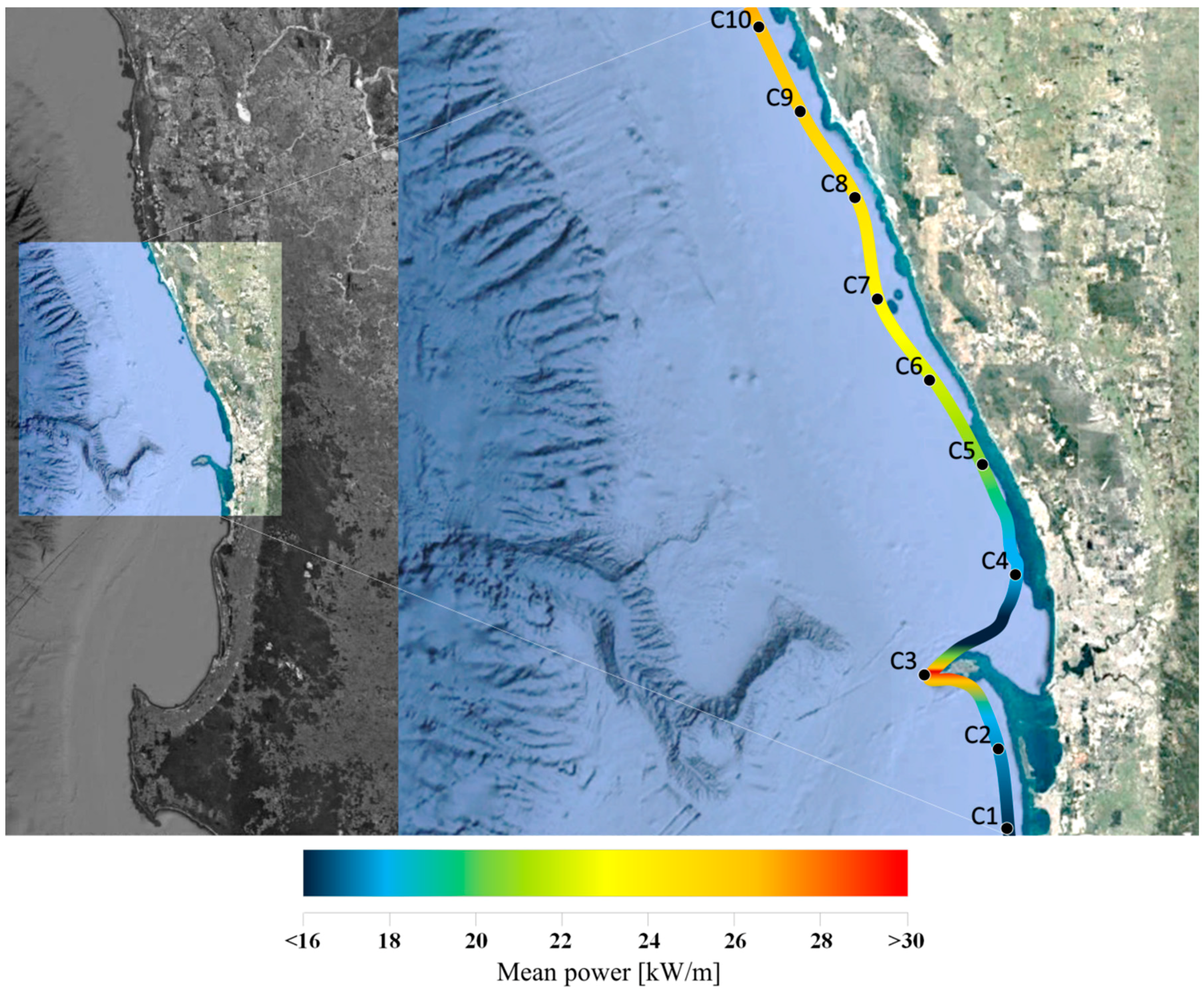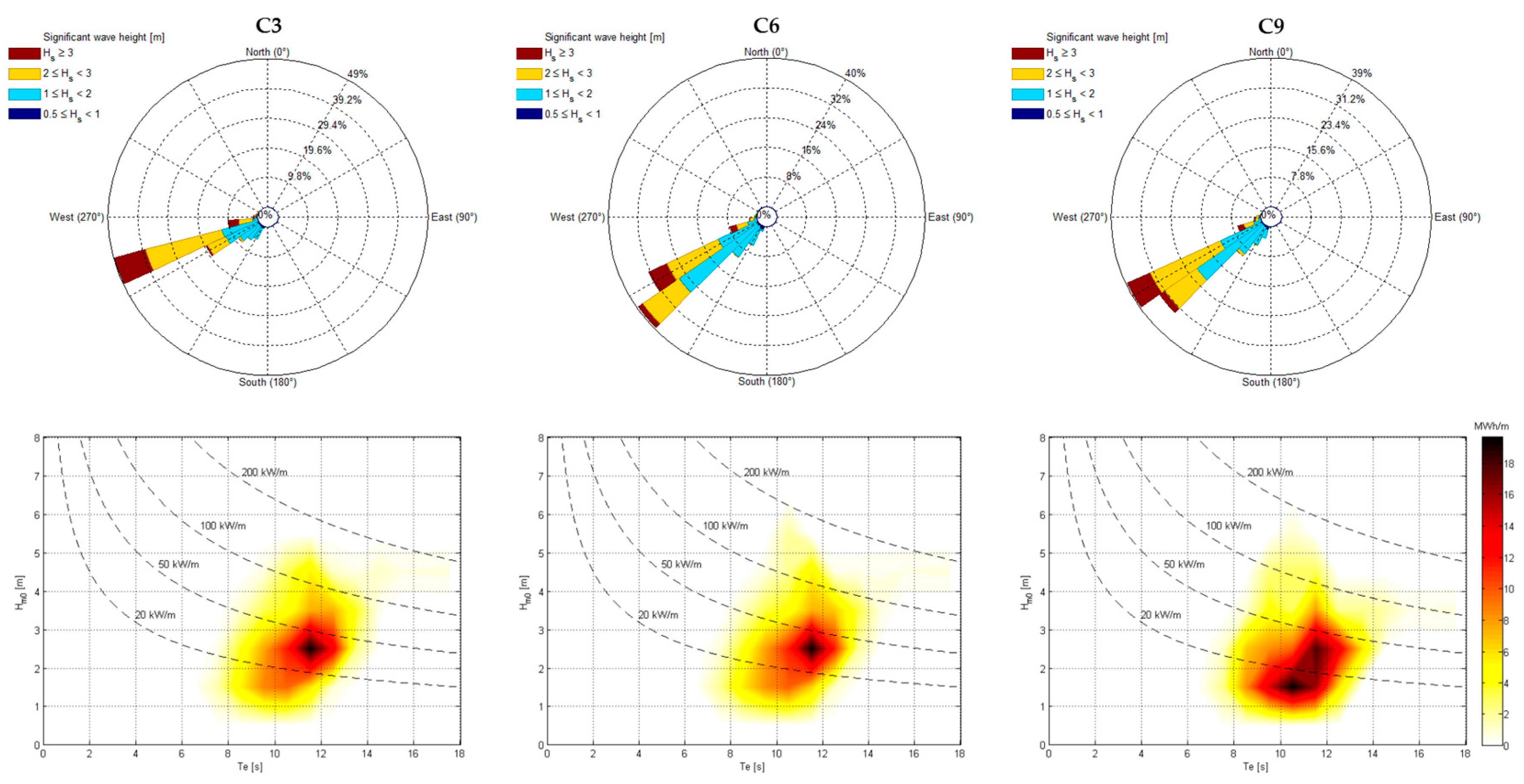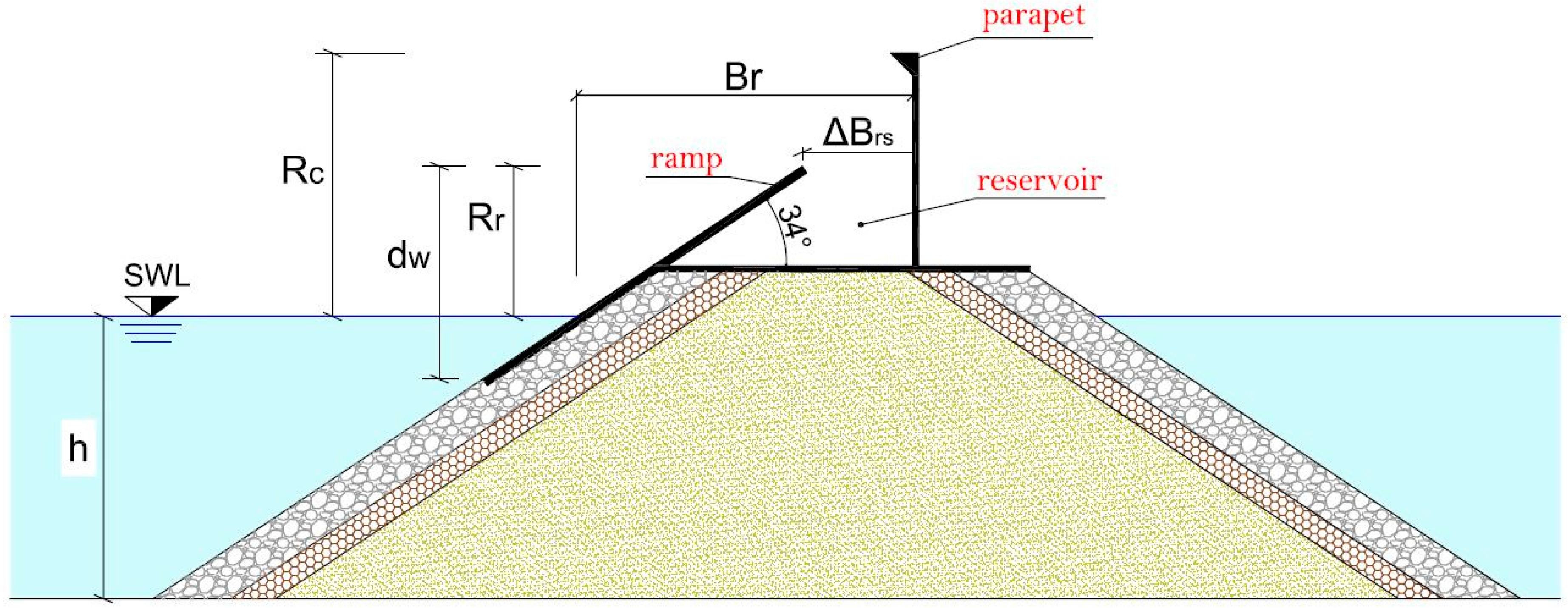2.1. Case Study
2.1.1. Coastal Area
The southwest coast of Australia provides a good case study to illustrate the assessment method. A detailed wave energy assessment is outlined, covering the coastline in one of the most favourable locations in the world for harvesting wave energy. The following summarizes the analysis of offshore and onshore wave power assessment of the Western Australia coasts. The region here considered is the NS oriented coastline, moving from Port Kennedy (45 km south of Perth) to Jurien Bay (about 195 km north of Perth). This coastal area has been chosen for several reasons:
- (1)
It represents one of the most energetic regions worldwide [
35], although only national-scale wave energy assessments are available [
36,
37,
38,
39,
40,
41,
42,
43,
44,
45];
- (2)
high seasonal stability level is registered;
- (3)
wave climate is characterized by a narrow wave directional sector;
- (4)
low tidal excursions, making possible the use of the OBREC technology;
- (5)
many harbours, marinas and other coastal defences are present, ensuring high realistic perspectives for OBREC installations (new breakwaters or integrated within existing coastal structures or their upgrades).
Hence, the coastline here analysed can be considered as one of the most favourable regions in the world for harvesting wave energy.
2.1.2. OBREC Technology
Any industrial and/or commercial harbour is a very high energy demanding system: traditional port construction, energy supply and consumption are no longer sustainable. It is necessary to innovate the way we conceive and design the port infrastructure through integration with elements of technological innovation. Within this framework, considerable R&D efforts have been dedicated to evolve from the traditional design concept of coastal structures “dissipating incoming wave energy by wave breaking/absorption” to a new concept of coastal structures “capturing the wave energy”. The breakwater becomes a Wave Energy Converter (WEC). In doing so, unlike all the other WEC installation which are “dedicated” and have an inherently environmental impact (foundations, interaction with wave, currents, sediment transport and vegetation), the WEC functionality of a coastal structure has null relative environmental impact.
Moving from experience on Sea-wave Slot-cone Generator [
4,
7,
8,
46,
47], an innovative built integrated device called the OBREC [
9] has been developed by the Research team from Second University of Naples. The peculiarities of the OBREC are the easier and less expensive operation and maintenance activities. In fact, it is built as a robust concrete structure with the turbine shaft and the gates controlling the water flow as virtually the only moving part in the mechanical system and the structure is safe even with malfunctioning of these moving parts (
Figure 2). Further, thanks to the sharing of the infrastructures and their construction costs (for the function of coastal defence), they tend to be more economically viable than offshore floating WECs, such as Wave Dragon [
2] and WaveCat [
3].
In the machine room, a set of low head turbines convert potential energy (water stored in the reservoirs) into kinetic energy and then into electrical energy by mean generators.
The OBREC prototype at Naples harbour hosts up to five turbines, three of which are already installed. These are low head fixed-Kaplan (propeller) turbines with a permanent magnet generator and a maximum power-point-tracking charge controller. An innovative hybrid “multi-field turbine”, obtained by coupling different kinds of turbine, is currently under development. For upcoming commercial applications, the traditional Archimedean screw turbine could be safely used, which is one of the oldest and most efficient very low head turbines. This screw turbine works on very low head (starting from 1 m or less) and requires relatively less flow rates for generating electricity at a significant level. Its main characteristics are mainly the low initial and maintenance costs and no fine water screening is required. High quality Archimedean screws exceed a design life of 25 years, as experienced worldwide.
2.1.3. Objectives and Approach
The energy production and efficiency of a WEC are always related to the local wave climate. Furthermore, water depths, geotechnical conditions and wave loading on the structure are significant, demanding a site-specific design. The identification of a site-specific design is a very complex process, involving:
the hydrodynamic performance, such as geometric optimization for energy flux harvesting and reduction of wave loading;
structural behaviour and fatigue analysis;
mooring/substructure/structure engineering;
preliminary environmental constrains;
inclusion of power absorption;
electrical cabling and secondary hydro-electrical equipment engineering;
power take-off, power smoothing and conditioning equipment project;
control system and strategy;
transportation feasibility analysis;
operation and maintenance optimization;
life cycle assessment and decommissioning.
After a proper site-specific device is designed, the Environmental Impact Assessment analysis must be carried out. This is a very multidisciplinary phase where potential impacts to be considered are [
48,
49,
50]: avoidance of shipping lanes, areas of military importance, marine archaeological sites and other special protection areas:
landscape and visual impact;
impacts on marine life and interaction with the marine environment including colonization patterns;
impact on recreation and other social activities (e.g., industrial fisheries, offshore/onshore platform etc.);
impact on local marine hydrodynamics;
sedimentary flow patterns (coastal erosion);
avoidance of areas of military importance, and marine archaeological sites;
navigation hazard;
acoustic noise and bioacoustics;
electromagnetic impact;
construction of temporary sites;
maintains operation impact.
It is well known that the executive WEC design is an outcome of improving a number of intermediate project ideas, satisfying a set of technical and non-technical requirements and subject to constraints. The technical design of a WEC could be synthesized in
Figure 3.
The study here presented focuses on the economic feasibility of OBREC installations, disregarding the nature conservation aspects, non-technical barriers and other matters included in the Environmental Impact Assessments related to wave energy conversion.
The proposed method works as a comparison analysis under functional, technological and economic constrains between a traditional rubble mound breakwater and the OBREC breakwater. The comparison is applied for 300 m of new main breakwater at each inshore study site described in the following section.
The work hypotheses for the structural design are:
mean overtopping at the rear of the structures lower than 0.050 m3/s per meter must be ensured;
foundation design aspects are neglected since geotechnical investigations are not available in the present analysis;
simple trapezoidal cross-sections (without berm) are considered for the rubble mound substructure;
armour layer (double layer) consists of sufficiently sized natural stone. In the case of very large stones (>10 tons) resulting from calculus, artificial concrete blocks (e.g., tetrapod) are used.
Rock slope stability for both types of breakwater; the Van der Meer formulae [
51,
52,
53] has been applied, assuming the fixed parameters reported in
Table 1.
The overtopping at the rear of the structure for traditional breakwater has been estimated with the formula proposed by [
54] using parameters proposed by [
55]. Once the crown wall crest level is known, Pedersen formulae [
56] have been applied in order to estimate wave loadings acting on the structure. For each OBREC, optimal geometry investigated all study sites; the overtopping flow rate at the rear side and the wave loading acting on the device have been estimated using equations proposed by [
9]. These formulas have been derived after two complementary model test campaigns were carried out in 2012 and 2014 at the Department of Civil Engineering at the Aalborg University (AAU) in Denmark.
In order to define the turbine strategy, an integrated technical/economic modelling approach has been applied. The purpose is to couple technical and economic parameters that influence the economic profitability of the OBREC technology. Moving from a detailed wave energy resource assessment, an estimation of the energy production of the OBREC at each specific site has been provided. Then, an economic study has been carried out in order to maximize the financial return on investments. The methodology has been applied with the data and procedure described below.
2.3. Resource Analysis
The expected energy production of a WEC can be estimated crossing the power matrix with the incident wave conditions (e.g., [
20,
27]. The OBREC prototype at Naples harbour (Italy), in operation since January 2016, represents the world’s first overtopping WEC totally integrated into an existing breakwater. As the monitoring has just begun, no definitive power matrix is available. For that reason, conservative values for power efficiency parameters are adopted in the present study. Considering the multiple interdependencies between the parameters involved, the only practical approach to solve the complexity of the optimisation task is represented by a software simulation of the system behaviour combined with a systematic parameter variation. A specially designed numerical model (OBRECsim) has been used to simulate energy production. The aim of the simulation is to determine the optimal geometry of the device and turbine strategy for which the energy production is maximized. The input parameters are:
wave characteristic of sea states;
tentative geometry of the device;
tentative turbine configuration.
Operatively, the waves from 10 year averaged 6 h triple dataset for S1–S9 were grouped by classes of
Hs–
Tp−
θm. The code simulates a time series of the mean water flow into the reservoir. The latter is found using the overtopping formula provided by [
9]. The numerical model is based on the continuity equation:
where
Qreservoir is the flow through turbines,
Qrear is the overtopping flow rate at the rear side of the structure and
Qoverflow is the reflected flow outgoing when the reservoir is saturated. In order to estimate electricity production, four levels of efficiency are taken into account:
- -
efficiency of the ramp, i.e., rate of total incident power overtopping the crests;
- -
efficiency of the reservoir, in terms of potential energy stored or lost for overflow in the reservoirs;
- -
turbines efficiency, as potential energy transformed into kinetic energy by turbines and related to start/stop penalties;
- -
electromechanical efficiency, as power take-off and generator efficiency and inverter losses.
In order to estimate the energy production, the efficiency curve of traditional turbines has been used in the present analysis. For each study site, different number and types of turbines are taken into account for optimisation analysis.
2.4. Economic Analysis
The so-called payback period method has been selected in this research as the economic analysis technique. This payback period is defined as the time required to completely recover the initial investment. It can be considered a significant determinant in a capital budgeting decision framework, as longer payback periods are typically not desirable for investment positions. Unlike other methods of capital budgeting, the method ignores the benefits that occur after the investment is repaid, while it could be effective in measuring investment risk. The formula to calculate payback period (PBP) expressed in years, is:
where:
- -
CAPEX (Capital expenditures) represents the initial investment assumed to be paid at time t = 0;
- -
Ci is the cash inflow, i.e., the annual revenue (AR) generated by incentive on renewable energy and/or electricity sales;
- -
Co is the annual cash outflow, due to operational and maintenance costs for the power system of OBREC (OPEX).
Due to the complex analysis of the OBREC financial performance, a second indicator is also chosen. This is the Net Present Value (
NPV), by which the profitability of a project could be easily quantified along its lifetime (
LT). It is expressed as:
CAPEX are calculated as:
where
CAPEXEM is the cost of electro-mechanical equipment, which is added to extra cost (or cost saving) related to Maritime Works necessary to build the OBREC breakwater instead of a traditional breakwater (
CAPEXMW,OBREC and
CAPEXMW,trad respectively) with the same overall safety performance.
Cable costs are mainly estimated on the basis of the number of turbines or modules’ length, assuming that the point of connection of the OBREC breakwater is electrified. The value of the discount rate,
r, largely affects the financial analysis. The indicative discount range for fixed WEC was 10%–14% [
63,
64,
65]. For comparison, traditional hydroelectric power generation had the discount rate 6%–9% [
65]. As known, the uncertainty about the specific value of
r increases with risk perception, often leading to internal inconsistencies in the mechanism used to estimate it. In this vein, the OBREC shows a less relative immaturity compared to other WEC technologies, being a fixed breakwater where waves operate on a quasi-traditional hydroelectric power system. For this reason, a nominal annual discount rate of 9% is fixed. According to the approach used by [
20], considering expected inflation of 1.3% [
66], a resulting real interest rate of 7.7% is assumed.
Policy mechanisms (e.g., feed-in-tariff) designed to accelerate investment in the wave energy sector in Western Australia are not yet defined, as is the case in several countries. For this reason, a probable socioeconomic scenario has been here defined, based on the feed-in tariff scheme applied in Western Australia to encourage the expansion of a residential solar energy system [
67]. Hence, the following assumptions have been made:
- (1)
a net feed-in-tariff of 40 cents per Kilowatt-hour over the next ten years, complementary to 8.4 cents currently paid under the Renewable Energy Buyback Scheme within the South West Interconnected System;
- (2)
the energy produced is not consumed by the producer (the Port Authority) during the first ten years, meaning a total of 48.4 cents for each unit of electricity exported to the grid;
- (3)
starting from the eleventh year, an average quote of 43% of electricity produced is directly consumed by the producer (reducing or helping meet peak demand);
- (4)
considering energy saving due to the self-production (with a mean electricity cost of 35.35 AUD/KWh) and the buyback excess electricity rate of 8.4094c per kWh (on 57% of total production) the effective value of electricity produced after this can be estimated as 20 cents per KWh.
For the calculation of
CAPEXEM and
OPEX, two options (Option 1 and 2) have been applied (see
Table 4). In Option 1, power production optimization was made using a large number of very economic propeller turbines. These turbines dominate the low head sector of the hydroelectric market. The model here used is one of the cheapest pico-turbines (ex-works price is AUD 1177.72 [
68]), with nominal power of 1.5 kW at 3 m head and a flow rate of 0.045 m
3/s. Its ex-works price is AUD 1177.72 [
68] and Based on the field experience made on the OBREC prototype, to that price the costs for an inox runner (AUD 400.00), plastic shaft (AUD 260.00), filter (AUD 140.00) and shipping (AUD 430.00) should be added. The cost of civil works that need to be completed to allow the scheme to run, broken down into intake, turbine mounting, outflow requirements and powerhouse is estimated at AUD 865. Therefore, the expected cost of the whole hydro-electromechanical system was fixed at AUD 2185.00 per kW.
The yearly operational and maintenance costs (OPEX) for pico-propellers are estimated as 5.5% of the initial cost, based on a conservative approach and experience gained from the OBREC prototype. A conservative equipment life of only 6 years has been selected. Hence, a complete replacement of pico turbines (and its inox runners), at least four times over a range of system lifetimes (24 years), is taken into account.
In Option 2, larger turbines are considered. In the first instance, the selected turbine architecture was the screw turbine, which works on low head and requires less flow rates that can be used for generating electricity at micro level. However, when the optimization procedure leads to flow rates greater than 5–6 mc/s, due to size problems (i.e., very large machine rooms are required, clearly in opposition with the confined space behind the crown wall), very low head (VLH) Kaplan turbines were used. Based on literature data and personal communication of a quote for the OBREC prototype, the costs of electro-mechanical equipment (including rotor, power train, generator and other equipment, cable costs, installation costs and grid connection costs) and related civil works (CAPEXEM) can be estimated using the following expressions:
For Kaplan turbine
where
P is the rated power (KW). Both equations have been calibrated on turbine size range and other technical specifications for OBREC operability (e.g., seawater corrosion inhibitors or cathodic protection, special hydraulic works, etc.). A 24 year technical and economic lifetime was assumed, although it is thought that the quality equipment used could reasonably last 25–27 years. The OPEX cost for screw and VLH Kaplan turbines in available projects suggested values ranging between 1.5% and 7% of the total project initial cost. In this study, an initial value of 2.8% with an annual raise level of 0.2% (i.e., a value of 7.4% at the 24th year of operative life) is assumed.
